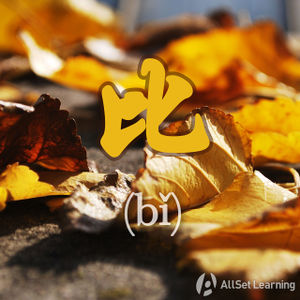Difference between revisions of "Basic comparisons with "bi""
| Line 74: | Line 74: | ||
== Pattern Using 比 and 更 == | == Pattern Using 比 and 更 == | ||
| − | This one is just a slight upgrade of the basic 比 (bǐ) comparison pattern, adding in 更 (gèng) before the adjective. 更 means "even more," so the idea is that while one thing is already quite [adjective], this other thing is '''''even more''''' [adjective]. Pretty simple! | + | This one is just a slight upgrade of the basic 比 (bǐ) comparison pattern, adding in [["Even more" with "geng"|更 (gèng) before the adjective]]. 更 means "even more," so the idea is that while one thing is already quite [adjective], this other thing is '''''even more''''' [adjective]. Pretty simple! |
=== Structure === | === Structure === | ||
| Line 109: | Line 109: | ||
Finally, to express [[Basic comparisons with "meiyou"|"not as... as," use 没有]], and to express [[Basic comparisons with "bu bi"|"not more... than" use 不比]] (the negative cousin of 比). | Finally, to express [[Basic comparisons with "meiyou"|"not as... as," use 没有]], and to express [[Basic comparisons with "bu bi"|"not more... than" use 不比]] (the negative cousin of 比). | ||
| − | + | Check these elementary comparison patterns out as well: | |
| − | + | ||
* [[Basic comparisons with "bu bi"]] | * [[Basic comparisons with "bu bi"]] | ||
* [[Basic comparisons with "meiyou"]] | * [[Basic comparisons with "meiyou"]] | ||
| + | |||
| + | When you're read for more, we also have a good overview of [[comparing|comparisons in Mandarin Chinese]] which spans all levels. | ||
== Sources and further reading == | == Sources and further reading == | ||
Revision as of 03:56, 12 August 2013
- Also known as: 比字句 (bǐzì jù).
-
Level
-
Similar to
-
Used for
-
Keywords
One of the most common ways of comparing things in Chinese is to use 比 (bǐ).
Contents
Basic Pattern Using 比
You could think of 比 (bǐ) as meaning "than," except that it sits between the two things being compared. The word order will take a little getting used to, but aside from that, the pattern is quite easy.
Structure
To say that one thing is more adjective than another, the structure is:
Noun 1 + 比 + Noun 2 + Adjective
The noun that's placed first is the one that comes out on top in the comparison. So in the sentence:
- 小李 比 小张 高 。Xiao Li is taller than Xiao Zhang.
小李 is taller. The same situation could be described as
- 小张 比 小李 矮 。
Examples
- 她 比 我 大 。She is older than me.
- 我 比 你 胖 。I'm fatter than you.
- 美国 比 英国 大 。The U.S. is bigger than the U.K.
- 这 条 路 比 那 条 长 。This road is longer than that road.
Common Errors
Try not to make these mistakes:
The adjective used in the comparison should be positive, not negative.
- 我 比 你 不 聪明 。I than you not smarter. (incorrect)
- 你 比 我 聪明 。You are smarter than me. (correct)
- 我 比 你 笨 。I am dumber than you. (correct)
比 is not used with 一样. 比 is used when two things are not the same.
- 我 比 你 一样 聪明 。I than you the same smart. (incorrect)
- 我 跟 你 一样 聪明 。I am as smart as you. (correct)
Pattern Using 比 and 更
This one is just a slight upgrade of the basic 比 (bǐ) comparison pattern, adding in 更 (gèng) before the adjective. 更 means "even more," so the idea is that while one thing is already quite [adjective], this other thing is even more [adjective]. Pretty simple!
Structure
Noun 1 + 比 + Noun 2 + 更 + Adjective
The only new thing here is the addition of 更 (gèng) before the adjective.
- 小李 比 小张 更 高 。Xiao Li is even taller than Xiao Zhang.
The implication is that while Xiao Zhang is tall, 小李 is even taller.
Examples
- 她 比 我 更 大 。She is even older than me.
- 我 比 你 更 胖 。I'm even fatter than you.
- 美国 比 英国 更 大 。The U.S. is even bigger than the U.K.
- 这 条 路 比 那 条 更 长 。This road is even longer than that road.
See Also
Finally, to express "not as... as," use 没有, and to express "not more... than" use 不比 (the negative cousin of 比).
Check these elementary comparison patterns out as well:
When you're read for more, we also have a good overview of comparisons in Mandarin Chinese which spans all levels.
Sources and further reading
Books
- Basic Patterns of Chinese Grammar (pp. 61-3) →buy
- Chinese: An Essential Grammar, Second Edition (pp. 53) →buy
- New Practical Chinese Reader 2 (新实用汉语课本2) (pp. 65-6) →buy
- Integrated Chinese: Level 1, Part 2 (3rd ed) (pp. 6- 8) →buy
- New Practical Chinese Reader 3 (新实用汉语课本3) (pp. 184-5) →buy
Websites
- East Asia Student: Simple comparisons in Mandarin Chinese
- Yale Chinese Usage Dictionary: Usage of 跟 and 比



